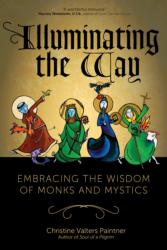 “Illuminating the Way: Embracing the Wisdom of Monks and Mystics”
“Illuminating the Way: Embracing the Wisdom of Monks and Mystics”
by Christine Valters Paintner; icons by Marcy Hall.
Sorin Books (Notre Dame, Indiana, 2016).
224 pp., $17.95.
“Illuminating the Way” excels for those looking for the horizontal church and horizontal spiritual practice, which is to say for a strong me-centered path of therapeutic religion. Such spirituality has close affinities to Carl Jung’s psychoanalysis, and unsurprisingly, author Christine Valters Paintner repeatedly turns to Jung to buttress her observations.
As the author would have it, I go to church to deepen my relationship with myself. My feelings and thoughts are the most interesting things around, and God helps me feel and think well. Religion is about subjective, personal experience. This book tends to discard the “militia Christi” aspects of saints for a soft, emotional religion, though the thoughts on Evagrius fighting the demons brings some relief.
[hotblock]
The book mixes interesting insights with unclear theology. St. Francis of Assisi conjures up the theologically irrelevant “archetype of the fool.” More seriously, the author bases her critique of the sins of Western culture’s “false god” of “productivity, striving, consumption and speed” on Franciscan spirituality. “There is a subversive act of truth-telling through the Fool’s humor and playfulness,” the author notes. These are timely words because the author links the holy fool – or “fool for Christ” — to humility.
We see more wisdom later in the book with the reference to the holy pause, or “statio,” whereby monks take a small break between tasks.
“When we rush from one thing to another, we skim over the surface of life,” Valters Paintner notes. The author, a Benedictine Oblate, repeatedly expresses her admiration for the order’s spirituality. (Benedictine Oblates, like the author, are laypeople who are associated with the Benedictines but do not make vows; lay Oblates have had a spiritual association with Benedictine monasteries for centuries.)
“Illuminating the Way” excels at emphasizing Christianity’s creative side. Yet it does so excessively, which is to say without the discipline and moderation that orthodoxy assures. The end of many chapters exemplify this with, for example, mandala art exercises where the mandala lacks Christian symbolism. How does such random art deepen the reader’s faith in Christ?
The skimpy theology is disappointing given what the author shows she knows of Christianity. The informative and accurate overview of the Egyptian desert fathers contrasts with the discussion on Mary, which stretches the bounds of Christian theology. She links the Virgin to pagan goddess spirituality: “My journey has been to the Great Mother, reclaiming the divine feminine in my life in a deeper way, and ultimately reclaiming/recovering/restoring the Mother who dwells within me and offers me everything I need in terms of nourishment, affection and attention.”
The chapter on St. Brigid accomplishes this direct fusion of Christian and pagan: “With her connection to the ancient goddess tradition, Brigid extends the lavish generosity of the Mother to us.” This leads to fairly Jungian, New Age conclusions: “The Healer is not only present in the traditional practice of medicine or other healing arts such as herbalism, massage, energy work, midwifery, and so forth. The Healer also works through spiritual direction, retreat work, psychotherapy.”
[hotblock2]
The author misses opportunities to speak of grace, such as when, once again, she discusses feelings and how to handle them: “When the undermining thoughts and stories, or the voices of the inner critic and judge, come up, notice them, and then as best you can, don’t let them take root. Try not to follow their trail that always leads to discouragement and self-doubt.” Instead of relying on grace, this Christ-less Christianity requires self-reliance. She never clearly shows God’s role in meditation and contemplation.
The theme of subversion comes up time and again, which shores up the author’s description of Dorothy Day: “Her faith was rooted in reaching out to the needs of others, and she was sustained by regular prayer and worship. Yet she often came into conflict with the church over her activities.” Both of these mirror themes among the wider American literature on Catholic spirituality, whereby respect for church authority and tradition is no longer valued.
“Illuminating the Way” offers many excellent insights, but is more faithful to contemporary feminist, psychotherapeutic, narcissistic culture than to the deposit of the faith.
***
Welter has degrees in history and theology, and teaches English in Taiwan.
PREVIOUS: For book on Pope Francis, author retraces pope’s life in Argentina, Rome
NEXT: ‘Face of Mercy’ documentary showcases living examples of mercy



Share this story